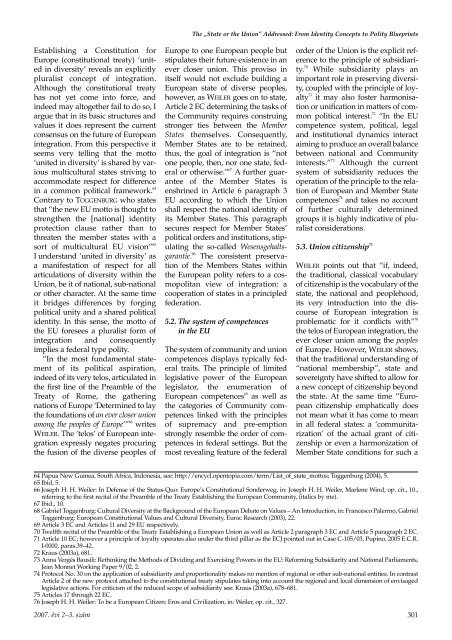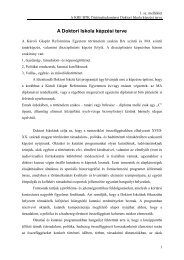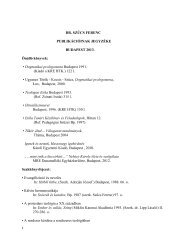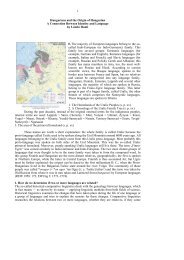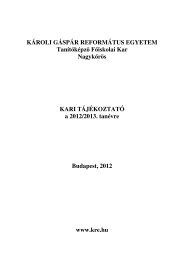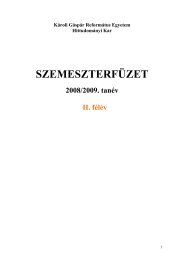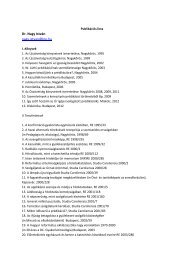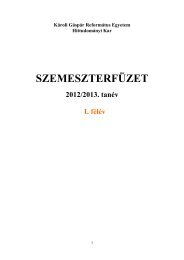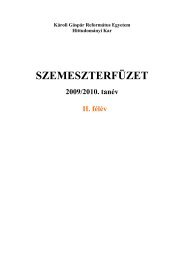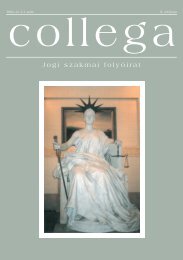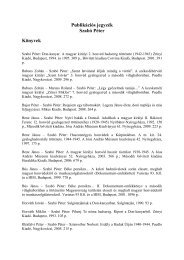collega - Károli Gáspár Református Egyetem
collega - Károli Gáspár Református Egyetem
collega - Károli Gáspár Református Egyetem
You also want an ePaper? Increase the reach of your titles
YUMPU automatically turns print PDFs into web optimized ePapers that Google loves.
The „State or the Union” Addressed: From Identity Concepts to Polity Blueprints<br />
Establishing a Constitution for<br />
Europe (constitutional treaty) ‘united<br />
in diversity’ reveals an explicitly<br />
pluralist concept of integration.<br />
Although the constitutional treaty<br />
has not yet come into force, and<br />
indeed may altogether fail to do so, I<br />
argue that in its basic structures and<br />
values it does represent the current<br />
consensus on the future of European<br />
integration. From this perspective it<br />
seems very telling that the motto<br />
‘united in diversity’ is shared by various<br />
multicultural states striving to<br />
accommodate respect for difference<br />
in a common political framework. 64<br />
Contrary to TOGGENBURG who states<br />
that “the new EU motto is thought to<br />
strengthen the [national] identity<br />
protection clause rather than to<br />
threaten the member states with a<br />
sort of multicultural EU vision” 65<br />
I understand ‘united in diversity’ as<br />
a manifestation of respect for all<br />
articulations of diversity within the<br />
Union, be it of national, sub-national<br />
or other character. At the same time<br />
it bridges differences by forging<br />
political unity and a shared political<br />
identity. In this sense, the motto of<br />
the EU foresees a pluralist form of<br />
integration and consequently<br />
implies a federal type polity.<br />
“In the most fundamental statement<br />
of its political aspiration,<br />
indeed of its very telos, articulated in<br />
the first line of the Preamble of the<br />
Treaty of Rome, the gathering<br />
nations of Europe ‘Determined to lay<br />
the foundations of an ever closer union<br />
among the peoples of Europe’” 66 writes<br />
WEILER. The ‘telos’ of European integration<br />
expressly negates procuring<br />
the fusion of the diverse peoples of<br />
Europe to one European people but<br />
stipulates their future existence in an<br />
ever closer union. This proviso in<br />
itself would not exclude building a<br />
European state of diverse peoples,<br />
however, as WEILER goes on to state,<br />
Article 2 EC determining the tasks of<br />
the Community requires construing<br />
stronger ties between the Member<br />
States themselves. Consequently,<br />
Member States are to be retained,<br />
thus, the goal of integration is “not<br />
one people, then, nor one state, federal<br />
or otherwise.” 67 A further guarantee<br />
of the Member States is<br />
enshrined in Article 6 paragraph 3<br />
EU according to which the Union<br />
shall respect the national identity of<br />
its Member States. This paragraph<br />
secures respect for Member States’<br />
political orders and institutions, stipulating<br />
the so-called Wesensgehaltsgarantie.<br />
68<br />
The consistent preservation<br />
of the Members States within<br />
the European polity refers to a cosmopolitan<br />
view of integration: a<br />
cooperation of states in a principled<br />
federation.<br />
5.2. The system of competences<br />
in the EU<br />
The system of community and union<br />
competences displays typically federal<br />
traits. The principle of limited<br />
legislative power of the European<br />
legislator, the enumeration of<br />
European competences 69<br />
as well as<br />
the categories of Community competences<br />
linked with the principles<br />
of supremacy and pre-emption<br />
strongly resemble the order of competences<br />
in federal settings. But the<br />
most revealing feature of the federal<br />
order of the Union is the explicit reference<br />
to the principle of subsidiarity.<br />
70<br />
While subsidiarity plays an<br />
important role in preserving diversity,<br />
coupled with the principle of loyalty<br />
71<br />
it may also foster harmonisation<br />
or unification in matters of common<br />
political interest. 72<br />
“In the EU<br />
competence system, political, legal<br />
and institutional dynamics interact<br />
aiming to produce an overall balance<br />
between national and Community<br />
interests.” 73<br />
Although the current<br />
system of subsidiarity reduces the<br />
operation of the principle to the relation<br />
of European and Member State<br />
competences 74 and takes no account<br />
of further culturally determined<br />
groups it is highly indicative of pluralist<br />
considerations.<br />
5.3. Union citizenship 75<br />
WEILER points out that “if, indeed,<br />
the traditional, classical vocabulary<br />
of citizenship is the vocabulary of the<br />
state, the national and peoplehood,<br />
its very introduction into the discourse<br />
of European integration is<br />
problematic for it conflicts with” 76<br />
the telos of European integration, the<br />
ever closer union among the peoples<br />
of Europe. However, WEILER shows,<br />
that the traditional understanding of<br />
“national membership”, state and<br />
sovereignty have shifted to allow for<br />
a new concept of citizenship beyond<br />
the state. At the same time “European<br />
citizenship emphatically does<br />
not mean what it has come to mean<br />
in all federal states: a ‘communitarization’<br />
of the actual grant of citizenship<br />
or even a harmonization of<br />
Member State conditions for such a<br />
64 Papua New Guinea, South Africa, Indonesia, see: http://encycl.opentopia.com/term/List_of_state_mottos; Toggenburg (2004), 5.<br />
65 Ibid, 5.<br />
66 Joseph H. H. Weiler: In Defense of the Status-Quo: Europe’s Constitutional Sonderweg, in: Joseph H. H. Weiler, Marlene Wind, op. cit., 10.,<br />
referring to the first recital of the Preamble of the Treaty Establishing the European Community, (italics by me).<br />
67 Ibid., 10.<br />
68 Gabriel Toggenburg: Cultural Diversity at the Background of the European Debate on Values – An Introduction, in: Francesco Palermo, Gabriel<br />
Toggenburg: European Constitutional Values and Cultural Diversity, Eurac Research (2003), 22.<br />
69 Article 3 EC and Articles 11 and 29 EU respectively.<br />
70 Twelfth recital of the Preamble of the Treaty Establishing a European Union as well as Article 2 paragraph 3 EC and Article 5 paragraph 2 EC.<br />
71 Article 10 EC; however a principle of loyalty operates also under the third pillar as the ECJ pointed out in Case C-105/03, Pupino, 2005 E.C.R.<br />
I-0000, paras.39–42.<br />
72 Kraus (2003a), 681.<br />
73 Anna Vergés Bausili: Rethinking the Methods of Dividing and Exercising Powers in the EU: Reforming Subsidiarity and National Parliaments,<br />
Jean Monnet Working Paper 9/02, 2.<br />
74 Protocol No. 30 on the application of subsidiarity and proportionality makes no mention of regional or other sub-national entities. In contrast<br />
Article 2 of the new protocol attached to the constitutional treaty stipulates taking into account the regional and local dimension of envisaged<br />
legislative actions. For criticism of the reduced scope of subsidiarity see: Kraus (2003a), 678–681.<br />
75 Articles 17 through 22 EC.<br />
76 Joseph H. H. Weiler: To be a European Citizen: Eros and Civilization, in: Weiler, op. cit., 327.<br />
2007. évi 2–3. szám<br />
301


